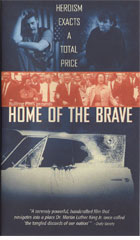
Home of the Brave 2003
Distributed by Bullfrog Films, PO Box 149, Oley, PA 19547; 800-543-FROG (3764)
Produced by Nancy Dickenson, Paola di Florio
Directed by Paola di Florio
VHS, color and b&, 76 min.
Sr. High - Adult
African American Studies, Human Rights, Law
Date Entered: 06/21/2005
Reviewed by Brian Falato, University of South Florida Tampa Campus LibraryOn March 25, 1965, Viola Liuzzo, a 39-year old mother of five from Detroit, was shot to death on a road outside Selma, Alabama. Mrs. Liuzzo had come to Alabama to help in the civil rights struggle and was transporting a black civil rights worker when she was killed. She became the only white woman to be murdered in the civil rights movement, and her death was a major spur to passage of the federal Voting Rights Act, enacted just months after her death.
Home of the Brave pays tribute to this comparatively little-known civil rights martyr, but does much more. It explores why she has been largely forgotten, shows the effect her death and its aftermath have had on her children, and examines the possibility of FBI complicity in her death.
As the video’s narrator, Stockard Channing, relates, Viola Liuzzo grew up poor in the South, the daughter of a coal miner. She moved North, married, had two kids, and then got divorced. A year and a half after the divorce, she married Teamsters union official Jim Liuzzo, and had three more children. She was moved to join in the fight for civil rights after watching news reports of “Bloody Sunday,” in which civil rights marchers were beaten by police as they attempted to cross the Edmund Pettus Bridge in Selma.
The identities of those involved in her murder were known by the FBI within hours after the incident. One of the men was an FBI informant on the Ku Klux Klan named Gary Thomas Rowe. Rowe received immunity and testified for the prosecution, but the three men arrested with him were found not guilty. And FBI Director J. Edgar Hoover seemed as interested in smearing Viola Liuzzo’s reputation as in bringing her killers to justice. The FBI compiled a 1000 page file on Mrs. Liuzzo, three times greater than the file on Ku Klux Klan activities. In the file were reports that Mrs. Liuzzo had sex with black civil rights workers and used drugs. Although these charges were unsubstantiated, Hoover had them leaked to the press in an effort to discredit the slain woman. (He also thought Jim Liuzzo had Mafia connections through his work with the Teamsters.)
Doubts have been cast on the official FBI explanation of the murder. Viola Liuzzo’s son Tony has studied crime scene photos and says the crime could not have occurred the way the FBI said it did. Two forensic analysts interviewed in the video agree with him. And the three suspects who were acquitted in the murder trial, but later served prison time for violating Mrs. Liuzzo’s civil rights, said upon their release from prison that Gary Thomas Rowe was the man who actually shot Mrs. Liuzzo, not the one the FBI identified as the trigger man. But Rowe could not be charged because a federal judge ruled he still had immunity from prosecution as a result of testifying at the first trial. And a Liuzzo family lawsuit against the federal government, charging the FBI with culpability for the murder because Rowe was on its payroll and either pulled the trigger or did nothing to stop the killing, was dismissed, with the Liuzzo family told it should pay court costs for the trial.
The effect all these events have had on the two Liuzzo sons adds a further twist to the story. Older brother Tommy Liuzzo disappeared into the Alabama backwoods after the failed lawsuit, and no one in the family has had contact with him in over twenty years. His brother Tony became a member of the Michigan Militia and broadcasted from an unlicensed radio station about his deep distrust of the government. After the September 11, 2001 attacks brought increased scrutiny of groups like the Michigan Militia, Tony disappeared too, and the rest of the family has not heard from him since.
Adding further emotion to the video is the trip daughter Mary Liuzzo takes to Selma to meet veterans of the civil rights struggle there, visit the site of her mother’s murder (a monument to it is surrounded by metal fencing), and, finally, touch her mother’s name on the sculpture at the Civil Rights Memorial in Montgomery, Alabama.
This video is highly recommended. The still-unanswered questions about Viola Liuzzo’s murder, the surprising outcomes of the Liuzzo brothers’ stories, and the emotional wallop of Mary’s visit to Alabama make this an engrossing and moving viewing experience.